The 7 foot diameter wind turbine is very similar to the 10 foot diameter design which is discussed in detail HERE.
The main frame of the machine is identical in every way except for the offset of the alternator. Instead of having the alternator offset 5 inches to the side
like we do on the 10 foot machine, this one is only offset 4 inches - so the alternator spindle is 1 inch closer to the yaw bearing than it is on the 10 foot machine.
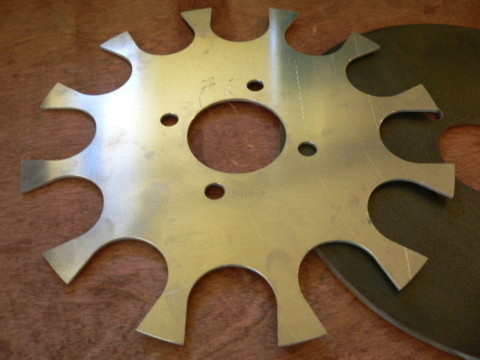
The 7 foot diameter machine uses different magnets. The magnets are 2 inches in diameter x 1/2 inch thick disks. Pictured above is the template
we used to build ours. You can make your own template - or... with round magnets it's fairly easy to get them evenly spaced with some kind of
'spacer'. In the past we often used playing cards. A couple rounds of trial and error and you'll find just the right stack of playing cards
that fits between the magnets so they come out spaced evenly around the disk.
UPDATE 2012-- The price of the round magnets for this wind turbine has gone through the roof. It's far more economical to use the 1 inch x 2 inch by 1/2 inch rectangular magnets from the 10 foot turbine in our book Homebrew Wind Power. When using rectangular magnets, wind this 7 footer with 2 strands of #15 AWG in hand, 53 turns per coil. For 24v, wind with 1 strand of #15 AWG, 105 turns per coil. And for 48v, wind with #18 AWG, 210 turns per coil.
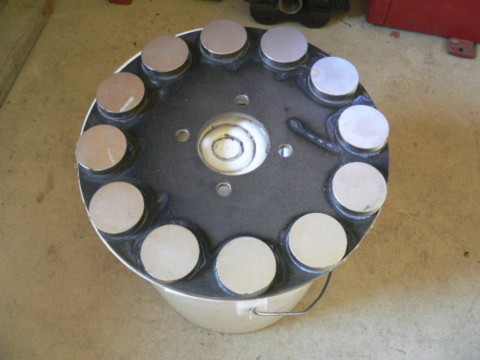
Pictured above all the magnets are glued down to the rotor. This machine only has 1 magnet rotor so you don't need to worry about aligning two rotors.
The rotor only needs the 4 holes - there is no need for jacking screws with only one rotor.
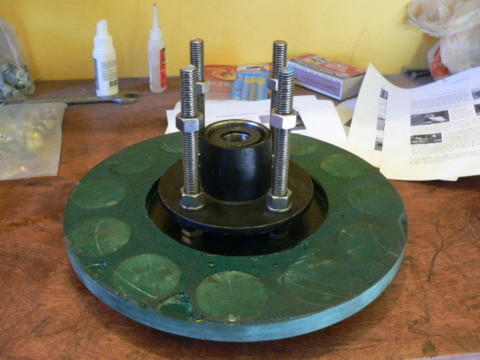
The magnet rotor mounts on the back of the wheel hub exactly like the back magnet rotor for the 10 foot machine. One magnet rotor is not the 'ideal' design for
an axial flux alternator. By not having a second rotor you do not have a 'complete' magnetic circuit so you're not making the best use of your magnets. But it's
a compromise... we're using more magnet than necessary, but the rest of the construction is simple. You don't need a second rotor, you don't need jacking screws... and you
can use the same parts and the same design as the 10 foot machine. So when assembling this machine follow the plans for the 10 foot machine exactly until it comes to the point
of mounting the front magnet rotor.
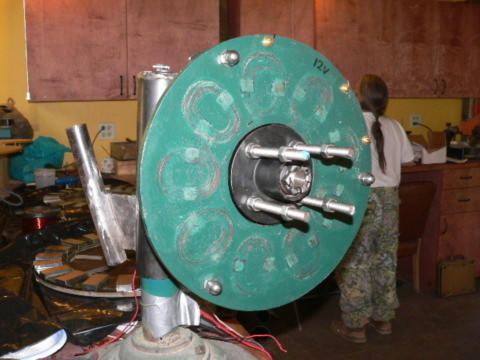
Mount the stator just like you would the 10 foot machine. The stator is identical except for the wire gage, and the number of turns. The coils
are exactly the same shape (use the same coil winder) and size. For a 12 Volt machine use 53 turns of #13 gage magnet wire. For a 24V system use
106 turns of #16 gage wire. For a 48V system use 212 turns of #19 gage wire per coil. There should be 3 coils in series per phase, and each phase should be
connected in star configuration exactly like the 10 foot machine.
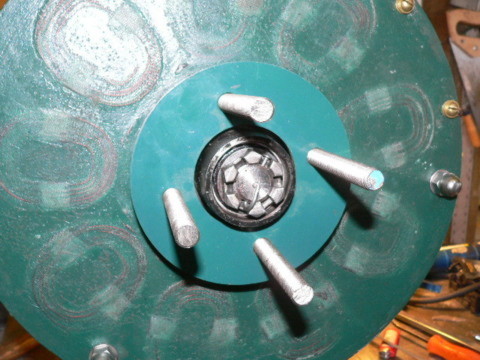
Just like the 10 foot machine, put a 1/4 inch thick, 6 inch diameter steel hub in the front of the alternator. With no front magnet rotor this machine should loose heat
from the stator pretty well in the wind.
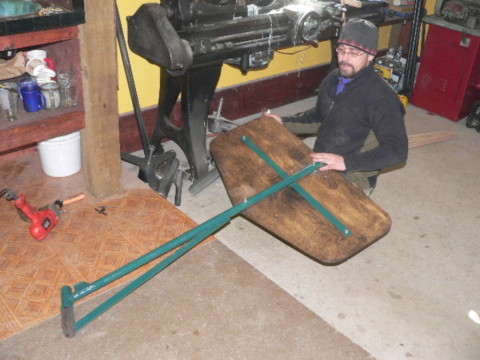
The tail is about the same as the 10 foot machine. On the 10 foot machine the tail boom is 5 feet long, on this one it's 4 feet long. As a general rule for this design the
tail boom is about the length of 1 blade (the radius of the blades). The tail on this one is proportionally smaller, but we keep it the same shape. Tail shape is optional but
a taller tail is more effective than a wider tail. Our tail measured 20 inches wide and 36 inches high. At the top and bottom it's 16 inches wide to give it a bit of an 'arrow' shape. Overall
it's about 4 square feet.
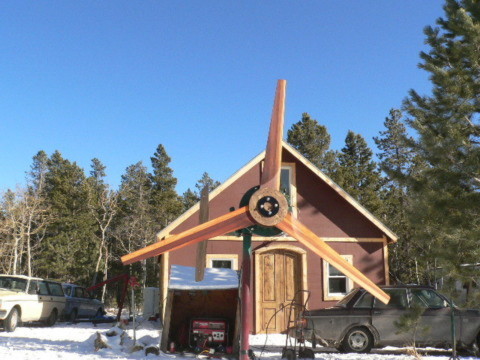
The rest of the machine assembles the same as the 10 foot machine. When finished you should expect about half the power from this that you'd
see from the 10 foot machine. 50 watts in 10mph winds give or take a bit, and it should start to furl at about 300 watts. Peak power (the most you'll ever see)
will be about twice that. It makes for a nice, small, lightweight machine. For a normal household it wouldn't be a drop in the bucket with regard to power needs - but for
a small cabin where lights and a radio are your only appliances it could go a long ways.
